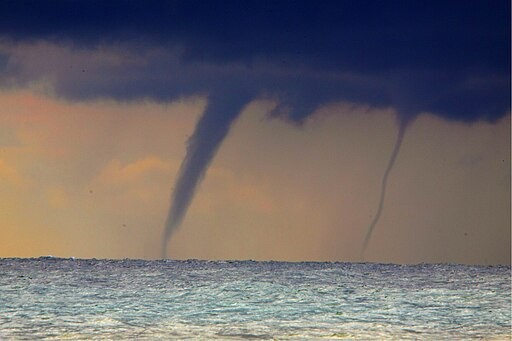In warm, tropical oceans, funnel clouds can be seen descending from stormy skies, moving like a ghostly spiral of wind that skim the surface of the sea. These eerie columns of rotating air are known as waterspouts.

What is a Waterspout?
A waterspout refers to a whirling column of air and water mist. It is a rotating cloud-filled wind that descends from a cumulus cloud to an ocean or lake. It is similar to a tornado but is usually smaller and less intense. They are most common in tropical and subtropical waters, like the Florida Keys, the islands of Greece, and off the east coast of Australia.
This formation of rapidly swirling air can fall into two categories: tornadic and fair-weather waterspouts. Tornadic waterspouts are tornadoes that either form over water or move from land to water, having the same characteristics as a land tornado. Since they are associated with severe thunderstorms, they are usually accompanied by large hail, high winds and seas, and frequent and dangerous lightning.
Tornadic waterspouts begin as true tornadoes and are influenced by winds associated with severe thunderstorms. As the air rises, it rotates on a vertical axis. This makes the tornadic waterspouts the most powerful and destructive type.
Meanwhile, fair-weather waterspouts are much more common but are rarely dangerous. They are formed along the dark, flat base of a line of developing cumulus clouds, which is generally not associated with thunderstorms. While tornadic waterspouts develop downward in a thunderstorm, a fair weather waterspout is formed on the surface of the water and works its way upward.
When the funnel becomes visible, a fair-weather waterspout is reaching its maturity. Another characteristic of fair weather waterspouts is their slow movement, brought by the light wind conditions that contribute to their formation.
An average waterspout measures 165 feet (50 meters) in diameter, with wind speeds of 50 miles per hour (80 kilometers per hour) lasting from five to ten minutes. This corresponds to the weakest types of tornadoes on land. On the other hand, the largest waterspouts can measure up to 330 feet (100 meters) and last up to an hour.
A waterspout that moves onshore can cause significant damage and injuries to people so that the National Weather Service may issue a tornado warning. In most cases, fair weather waterspouts rapidly dissipate when they land, so they rarely penetrate far inland.
How Do Waterspouts Form?
Despite its name, a waterspout is not filled with water from the ocean or lake. In fact, it does not "spout" from the water. Instead, the water inside a waterspout results from condensation in the cloud. Both tornadic and fair-weather waterspouts require high levels of humidity and a relatively warm water temperature compared to the overlying air.
There are five stages of waterspout formation. First, the water surface becomes dark when the column of rotating wind reaches it. Then, the light and dark bands spiral out from the dark spot. The formation of a cascade of a swirling ring of sea spray around the dark spot follows this. Next, the waterspout becomes visible from the water's surface to the clouds overhead and is now at its most intense stage. Finally, the water collapses when the flow of warm air into the vortex weakens.
Check out more news and information on Tornado in Science Times.
© 2025 ScienceTimes.com All rights reserved. Do not reproduce without permission. The window to the world of Science Times.










